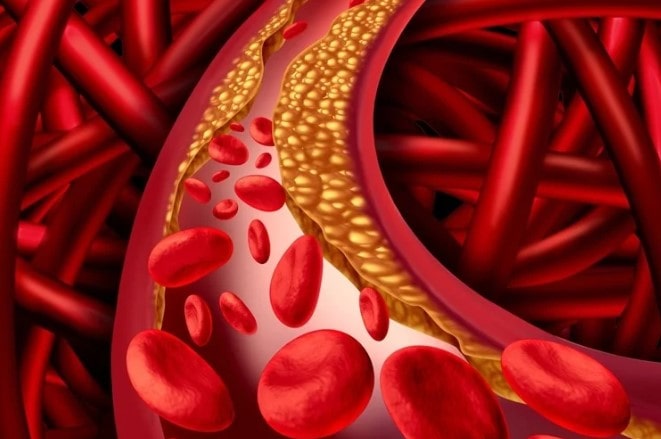Why Hypertension Is Linked To Atherosclerosis?

Hypertension and atherosclerosis are two prevalent cardiovascular conditions that are closely intertwined. The objective of this article is to explore the physiological relationship between hypertension and atherosclerosis, shedding light on the reasons behind their strong association.
By examining the impact of hypertension on arterial health, common risk factors shared by these conditions, and the role of endothelial dysfunction and vascular damage, a comprehensive understanding of their link can be achieved.
Moreover, the article will delve into the silent nature of hypertension and its potential to contribute to atherosclerotic complications. The importance of effective treatment strategies for managing both conditions will also be discussed, along with the crucial role of prevention and management in reducing the burden of hypertension and atherosclerosis.
By adopting an academic style of writing that maintains objectivity and avoids personal pronouns, this article aims to provide an unbiased and evidence-based exploration of the relationship between hypertension and atherosclerosis.
Key Takeaways
- Hypertension and atherosclerosis are interconnected conditions that exacerbate each other.
- Early detection and management of hypertension is crucial in preventing atherosclerosis and its complications.
- Lifestyle modifications, such as adopting a healthy diet and regular physical activity, play a crucial role in managing both conditions.
- Hypertension promotes inflammation in the arterial wall, leading to the initiation and progression of atherosclerosis.
Physiology of Hypertension and Atherosclerosis
The pathophysiology of hypertension involves the chronic elevation of blood pressure, which contributes to the development and progression of atherosclerosis in various ways.
The pathogenesis of hypertension is multifactorial and involves complex interactions between genetic, environmental, and lifestyle factors. Increased blood pressure leads to endothelial dysfunction and impaired nitric oxide production, promoting the adhesion of inflammatory cells and the formation of foam cells within the arterial wall.
Furthermore, hypertension induces oxidative stress and inflammation, which further exacerbate vascular damage and promote the accumulation of lipids and inflammatory cells.
The pathogenesis of atherosclerosis involves the accumulation of lipids, cholesterol, and inflammatory cells within the arterial wall, leading to the formation of atherosclerotic plaques.
Hypertension contributes to the progression of atherosclerosis by promoting endothelial dysfunction, inflammation, and oxidative stress, ultimately increasing the risk of cardiovascular events.
Impact of Hypertension on Arterial Health
One important factor to consider when examining the impact of high blood pressure on the health of arteries is its influence on the development and progression of arterial disease. Hypertension, or high blood pressure, puts constant stress on the arterial walls, leading to structural changes and damage.
This chronic stress can lead to the development of atherosclerosis, a condition characterized by the buildup of fatty plaques in the arteries. The impact of stress on arterial health is multifactorial, involving various mechanisms such as inflammation, oxidative stress, and endothelial dysfunction.
Additionally, genetics play a role in hypertension, with certain genetic variants predisposing individuals to develop high blood pressure. These genetic factors can also contribute to the development of atherosclerosis and further exacerbate the impact of hypertension on arterial health.
Understanding these complex interactions is essential for developing effective strategies for the prevention and treatment of hypertension and atherosclerosis.
Common Risk Factors for Hypertension and Atherosclerosis
Genetic and environmental factors contribute significantly to the development and progression of both high blood pressure and the buildup of fatty plaques in arteries, emphasizing the importance of understanding and addressing these common risk factors.
Common risk factors for hypertension and atherosclerosis include age, obesity, smoking, physical inactivity, and a diet high in saturated fats.
Physiological mechanisms underlying the link between hypertension and atherosclerosis involve endothelial dysfunction, oxidative stress, inflammation, and the activation of the renin-angiotensin-aldosterone system.
Hypertension leads to increased pressure within the arteries, causing damage to the endothelial lining and promoting the infiltration of cholesterol and inflammatory cells. This leads to the formation of fatty plaques, narrowing the arterial lumen and compromising blood flow.
Additionally, hypertension accelerates atherosclerosis by promoting the proliferation of smooth muscle cells and fibrous tissue formation.
Understanding and addressing these shared risk factors is crucial in the prevention and management of both hypertension and atherosclerosis.
Endothelial Dysfunction and Vascular Damage
This paragraph will discuss the key points of impaired nitric oxide production, increased permeability, and plaque formation in relation to endothelial dysfunction and vascular damage.
Impaired nitric oxide production refers to the reduced ability of the endothelium to produce sufficient amounts of nitric oxide, a molecule that plays a crucial role in maintaining vascular health. This impairment can lead to reduced vasodilation and increased vascular tone, contributing to the development of hypertension and atherosclerosis.
Increased permeability refers to the heightened leakage of substances across the endothelial barrier, which can allow for the infiltration of inflammatory cells and lipids into the arterial wall, promoting the formation of atherosclerotic plaques.
Overall, these mechanisms of endothelial dysfunction contribute to vascular damage and the progression of hypertension and atherosclerosis.
Impaired nitric oxide production
Impaired nitric oxide production has been implicated in the association between hypertension and atherosclerosis. Nitric oxide (NO) is a crucial molecule that regulates vascular tone and maintains endothelial function. When NO production is impaired, it leads to endothelial dysfunction, impaired blood flow, and increased oxidative stress. This, in turn, promotes the development of atherosclerosis.
The following factors contribute to impaired nitric oxide production in hypertensive individuals:
- Reduced endothelial nitric oxide synthase (eNOS) activity: Hypertension decreases the expression and activity of eNOS, the enzyme responsible for NO production.
- Increased oxidative stress: Hypertension is associated with elevated production of reactive oxygen species, which can scavenge NO and impair its bioavailability.
- Endothelial cell dysfunction: Hypertension causes structural and functional changes in endothelial cells, leading to reduced NO production.
- Endothelin-1 overexpression: Hypertension is associated with increased endothelin-1 levels, which can inhibit NO synthesis and promote vasoconstriction.
Impaired nitric oxide production contributes to the development and progression of atherosclerosis in hypertensive individuals by promoting endothelial dysfunction and oxidative stress.
Increased permeability and plaque formation
Increased permeability of blood vessels facilitates the formation of plaques, contributing to the progression of cardiovascular disease.
Hypertension is linked to atherosclerosis due to the increased vascular permeability observed in hypertensive individuals. This increased permeability allows for the infiltration of lipids and inflammatory cells into the arterial wall, leading to the development of atherosclerotic plaques.
Moreover, hypertension induces endothelial dysfunction, impairing the integrity of the endothelial layer and further promoting the entry of atherogenic substances into the vessel wall.
Once formed, these plaques can undergo rupture, triggering the formation of blood clots and potentially leading to life-threatening events such as heart attacks or strokes.
Therefore, the increased permeability associated with hypertension plays a crucial role in the pathogenesis of atherosclerosis and highlights the importance of managing blood pressure to reduce the risk of cardiovascular complications.
Hypertension as a Silent Killer
Hypertension, often referred to as the silent killer, stealthily infiltrates the cardiovascular system, its presence lurking undetected like a shadow in the night.
This condition, characterized by abnormally high blood pressure, often goes unnoticed due to the absence of overt symptoms. However, its long-term consequences are grave, with atherosclerosis being one of the major complications associated with hypertension.
Atherosclerosis, the buildup of plaque in the arteries, occurs as a result of increased vascular permeability caused by hypertension. The elevated pressure damages the endothelial lining of the blood vessels, leading to the deposition of lipids and immune cells.
Over time, this plaque formation narrows the arteries, impeding blood flow and increasing the risk of cardiovascular events such as heart attacks and strokes.
Therefore, raising silent killer awareness and implementing appropriate measures for early detection and management of hypertension is crucial in preventing the development of atherosclerosis and its associated complications.
Treatment Strategies for Hypertension and Atherosclerosis
Hypertension, often referred to as the silent killer, is a major risk factor for atherosclerosis. However, it is important to note that hypertension and atherosclerosis are not independent entities, but rather interconnected conditions that exacerbate each other.
Moving on to the current subtopic, treatment strategies for hypertension and atherosclerosis aim to manage blood pressure and reduce the progression of atherosclerotic plaque. There are several treatment options available, including medication such as antihypertensive drugs and lipid-lowering agents.
However, in addition to medication, lifestyle modifications play a crucial role in managing both conditions. These modifications include adopting a healthy diet, engaging in regular physical activity, maintaining a healthy weight, quitting smoking, and managing stress.
By incorporating these lifestyle changes, individuals can significantly reduce their risk of developing hypertension and atherosclerosis.
The Role of Hypertension in Atherosclerotic Complications
The relationship between high blood pressure and the complications of atherosclerosis showcases the interplay between two interconnected conditions. Hypertension plays a significant role in the development and progression of atherosclerotic complications.
One key factor is the role of inflammation. Hypertension promotes inflammation in the arterial wall, leading to the initiation and progression of atherosclerosis. Elevated blood pressure increases shear stress on the endothelial lining, triggering endothelial dysfunction, which results in the release of pro-inflammatory cytokines and adhesion molecules. This inflammatory response attracts immune cells, such as monocytes, to the site of injury, leading to the formation of foam cells and the development of atherosclerotic plaques.
Additionally, hypertension promotes oxidative stress, further contributing to endothelial dysfunction and inflammation.
Overall, hypertension plays a crucial role in the pathogenesis of atherosclerosis, highlighting the importance of blood pressure control in preventing atherosclerotic complications.
Prevention and Management of Hypertension and Atherosclerosis
Preventive measures and effective management strategies are essential in mitigating the impact of high blood pressure and its association with the development and progression of atherosclerotic complications. Preventing hypertension and atherosclerosis involves implementing lifestyle modifications that target the underlying risk factors. These modifications include adopting a healthy diet low in sodium and saturated fats, engaging in regular physical activity, maintaining a healthy weight, limiting alcohol consumption, and avoiding tobacco use. Additionally, managing hypertension and atherosclerosis requires close monitoring of blood pressure levels and adherence to prescribed medications. Regular check-ups with healthcare professionals are crucial for evaluating the effectiveness of the management plan and making necessary adjustments. By implementing these measures, individuals can reduce the risk of developing hypertension and atherosclerosis and minimize the potential complications associated with these conditions.
| Lifestyle Modifications for Managing Hypertension and Atherosclerosis | |||
|---|---|---|---|
| Healthy Diet | Regular Exercise | Weight Management | Limit Alcohol |
| Consumption | |||
| Low Sodium | Avoid Tobacco Use | ||
| and Saturated Fats |
Frequently Asked Questions
What is the specific role of hypertension in the development of atherosclerosis?
Hypertension plays a crucial role in the development of atherosclerosis through multiple mechanisms. It promotes inflammation, which leads to endothelial dysfunction and the recruitment of immune cells, and also increases oxidative stress, causing further damage to the arterial walls.
How does endothelial dysfunction contribute to the progression of hypertension and atherosclerosis?
Endothelial dysfunction mechanisms, such as impaired nitric oxide production and increased oxidative stress, play a crucial role in the progression of hypertension and atherosclerosis. Oxidative stress contributes to vascular inflammation and endothelial damage, promoting the development and progression of both conditions.
Are there any specific lifestyle factors that can increase the risk of developing both hypertension and atherosclerosis?
Specific lifestyle factors, such as a sedentary lifestyle, unhealthy diet, smoking, excessive alcohol consumption, and chronic stress, can significantly increase the risk of developing both hypertension and atherosclerosis.
Can hypertension and atherosclerosis be completely prevented through lifestyle changes alone?
Prevention strategies focusing on lifestyle changes alone can mitigate the risk of developing hypertension and atherosclerosis, but complete prevention may not be possible. Medication can also play a crucial role in managing these conditions.
What are the long-term complications of atherosclerosis that can arise from untreated hypertension?
Long-term consequences of untreated hypertension include increased risk of atherosclerosis, which can lead to various cardiovascular complications such as heart attack, stroke, and peripheral artery disease. This highlights the significant impact of hypertension on cardiovascular health.









